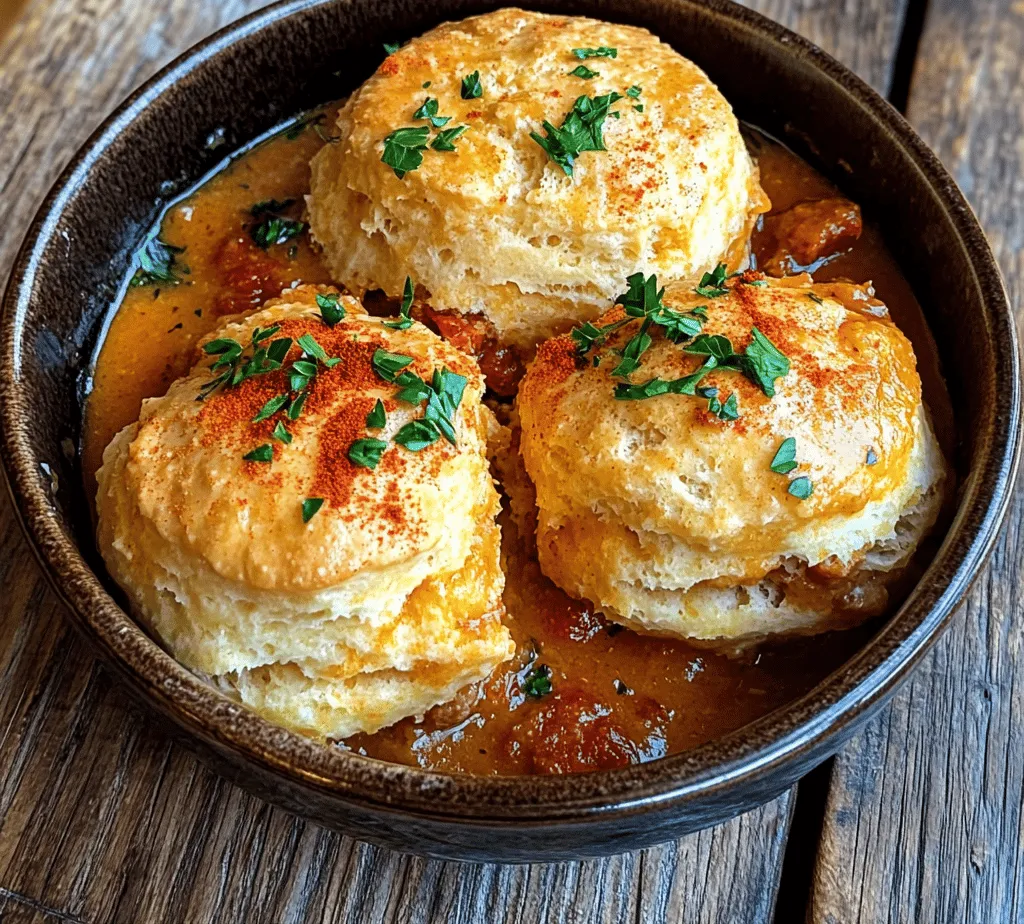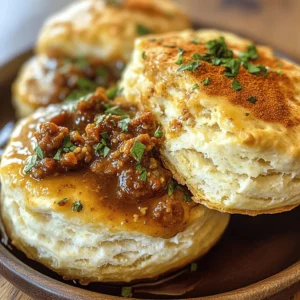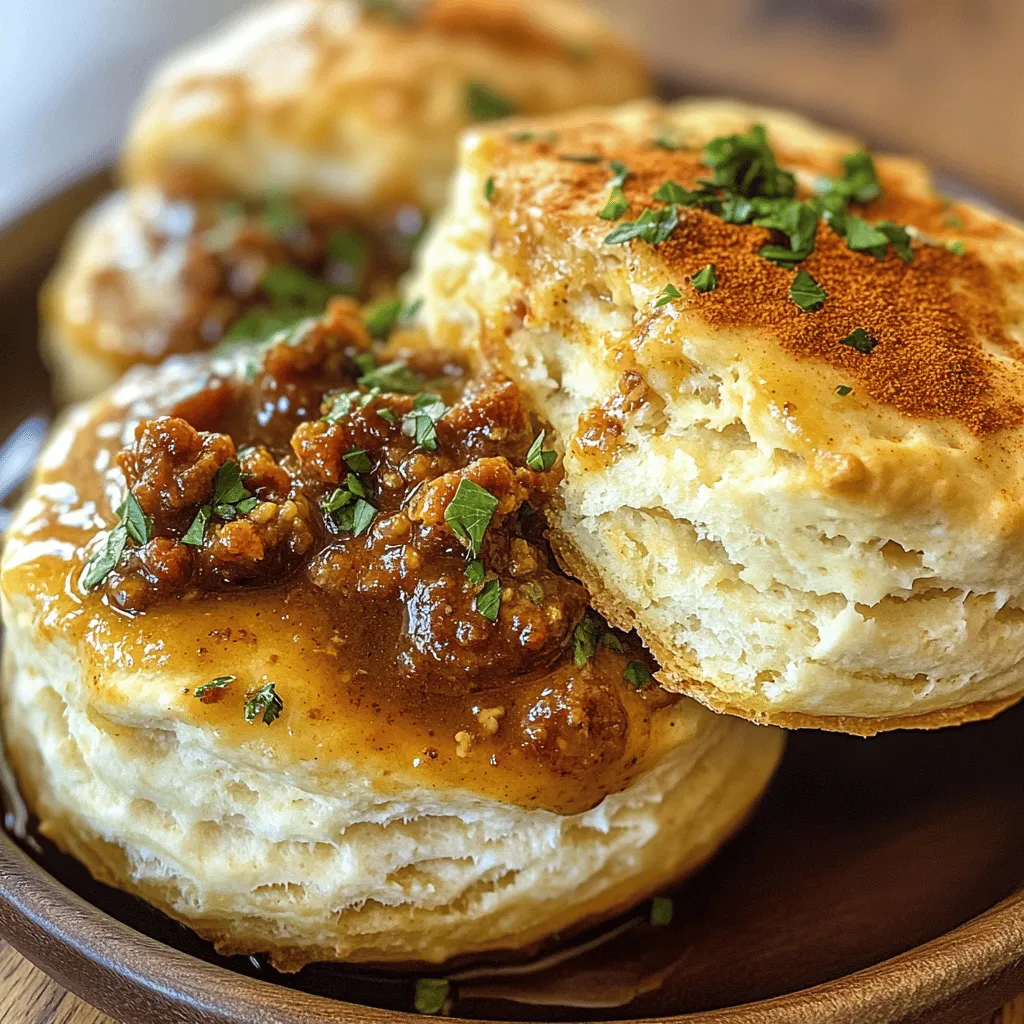Introduction
Southern cooking is a culinary tradition that encompasses warmth, hospitality, and comfort. At the heart of this beloved cuisine lies the iconic dish of biscuits and gravy, a staple that has graced breakfast tables across the southern United States for generations. This dish captures the essence of comfort food with its combination of fluffy, buttery biscuits paired with a rich, spicy chorizo gravy. It’s a meal that not only fills the stomach but also warms the heart, making it a favorite for both seasoned cooks and those just beginning their culinary journey.
The beauty of biscuits and chorizo gravy lies in their simplicity and the joyful experience of making them from scratch. While traditional biscuits and gravy often feature sausage, the addition of chorizo introduces a delightful twist that elevates this dish to new heights. The spicy notes of chorizo meld perfectly with the creamy gravy, creating a flavor profile that is both satisfying and delectable. Whether you are preparing it for a leisurely weekend brunch or a comforting weekday dinner, this recipe promises to deliver an unforgettable experience.
In this article, we will not only guide you through the preparation of this Southern delight but also delve into the history, significance, and nuances of each ingredient used. By the end, you’ll be equipped with all the knowledge and skills needed to recreate this dish in your own kitchen, ensuring that anyone can enjoy this delightful meal at home.
Understanding the Ingredients
To master the art of biscuits and chorizo gravy, it’s essential to understand the key components of the recipe. Each ingredient plays a vital role in contributing to the dish’s overall flavor and texture, creating a harmonious blend that celebrates the spirit of Southern cooking.
The Role of Biscuits in Southern Cuisine
Biscuits are more than just a side dish in Southern cuisine; they are a cultural icon. Originating from the early European settlers, biscuits have evolved over time, taking on various forms and flavors. Traditionally made with simple ingredients, biscuits were a practical solution for using available resources while providing sustenance. Over the years, they have transformed into a versatile staple found in countless Southern dishes, from breakfast to dinner.
The significance of biscuits in Southern cooking goes beyond mere sustenance; they symbolize hospitality and warmth. A freshly baked biscuit served with a dollop of butter or a generous pour of gravy has the power to bring people together, making it a cherished part of family gatherings and celebrations. Their light, flaky texture and buttery goodness make them the perfect canvas for rich gravies, further solidifying their place in Southern culinary tradition.
Breaking Down the Biscuit Ingredients
Creating the perfect biscuit involves a careful selection of ingredients, each contributing to the desired texture and flavor. Let’s take a closer look at these essential components:
– All-Purpose Flour: This is the foundation of the biscuit. It provides the structure needed to hold the biscuits together while allowing them to rise beautifully. The quality of the flour can significantly affect the final product, so opting for a good brand is essential.
– Baking Powder and Baking Soda: These leavening agents are crucial for achieving the light, fluffy texture characteristic of Southern biscuits. Baking powder provides the bulk of the lift, while baking soda helps with browning and flavor.
– Salt and Sugar: Salt enhances the flavor of the biscuits, bringing out the natural sweetness of the ingredients. A touch of sugar balances the savory elements, creating a well-rounded biscuit that complements the richness of the gravy.
– Cold Unsalted Butter: The temperature and fat content of the butter are vital for creating flaky layers in the biscuits. Cold butter, when cut into the flour, creates little pockets of fat that expand during baking, resulting in tender, flaky layers.
– Buttermilk: This ingredient not only adds a tangy flavor but also reacts with the baking soda to create additional lift. The acidity in buttermilk tenderizes the gluten, ensuring that the biscuits remain soft and moist.
Crafting the Perfect Biscuit
Now that we understand the ingredients, let’s walk through the step-by-step process of making the perfect Southern biscuits. Follow these guidelines closely to achieve delicious, fluffy biscuits that will serve as the perfect foundation for your chorizo gravy.
1. Prepping the Oven: Preheat your oven to 450°F (232°C). A hot oven is crucial for ensuring that the biscuits rise quickly and develop a golden-brown crust.
2. Mixing the Dry Ingredients: In a large mixing bowl, combine the all-purpose flour, baking powder, baking soda, salt, and sugar. Whisk together until evenly mixed. This step is essential for distributing the leavening agents evenly throughout the flour.
3. Cutting in the Butter: Using a pastry cutter or your fingers, cut the cold unsalted butter into the dry mixture. The goal is to create pea-sized pieces of butter that are evenly distributed throughout the flour. This technique is key to achieving the flaky texture that Southern biscuits are known for.
4. Incorporating the Buttermilk: Make a well in the center of the flour mixture and pour in the cold buttermilk. Gently stir until just combined—be careful not to overmix, as this can lead to tough biscuits.
5. Kneading and Shaping: Turn the dough out onto a lightly floured surface. Gently knead the dough 3-4 times, just until it comes together. Pat it into a rectangle about 1-inch thick. Use a biscuit cutter or a glass to cut out biscuits, being careful not to twist the cutter, as this can seal the edges and prevent rising.
6. Baking to Golden Perfection: Place the cut biscuits on a baking sheet lined with parchment paper, ensuring they are close but not touching. Bake in the preheated oven for 12-15 minutes, or until golden brown on top. The aroma of freshly baked biscuits will fill your kitchen, beckoning everyone to the table.
Exploring Chorizo Gravy
While the biscuits are baking, let’s turn our attention to the star of the show: the chorizo gravy. Chorizo, a spicy sausage with roots in Spanish and Mexican cuisine, adds a unique depth of flavor to traditional gravy. Its bold spices and rich fat content elevate the dish, creating a savory sauce that perfectly complements the fluffy biscuits.
Chorizo gravy is characterized by its vibrant color and robust flavor, often featuring ingredients like garlic, onion, and a blend of spices that may include smoked paprika, cumin, and chili powder. The result is a creamy, rich gravy that is not only delicious but also provides a satisfying kick, making it a favorite among those who enjoy a little heat in their meals.
As we prepare to delve into the specific ingredients for the chorizo gravy, it’s important to remember that this dish is all about balance. The spice of the chorizo should harmonize with the creamy texture of the gravy, creating a delightful contrast that enhances the overall experience.
Ingredients for the Chorizo Gravy
To create the perfect chorizo gravy, gather the following ingredients:
– Chorizo Sausage: Fresh chorizo is ideal for this recipe, as its flavor and fat content are essential for a rich gravy. You can choose between spicy or mild varieties depending on your heat preference.
– Onion: A finely chopped onion adds sweetness and depth to the gravy, balancing the spiciness of the chorizo.
– Garlic: Minced garlic infuses the gravy with aromatic flavor, making each bite more savory.
– All-Purpose Flour: This ingredient is used to create a roux, thickening the gravy and giving it a smooth consistency.
– Chicken or Vegetable Broth: This liquid adds richness and flavor to the gravy, ensuring it’s not too thick or too thin.
– Heavy Cream or Milk: Adding cream or milk creates a luxuriously smooth texture, elevating the gravy and making it even more indulgent.
– Seasonings: Common seasonings include black pepper, smoked paprika, and a dash of hot sauce, allowing you to customize the heat level to your liking.
By understanding the ingredients and their roles in both the biscuits and the chorizo gravy, you can create a dish that is not only flavorful but also deeply satisfying. In the next section, we will walk you through the preparation of the chorizo gravy, ensuring that every bite of your Spicy Southern Delight is an experience to remember.

Spicy Southern Delight: Biscuits & Chorizo Gravy
Chorizo Sausage: Types and Flavor Profiles
Chorizo is the star ingredient in this spicy Southern dish, and its rich, robust flavors are what elevate biscuits and gravy to a whole new level. There are two primary types of chorizo that you can use in this recipe: Mexican chorizo and Spanish chorizo.
Mexican chorizo is a fresh sausage made from ground pork, flavored with a blend of spices, including chili powder, garlic, and vinegar. It is typically sold raw and needs to be cooked before eating. This type of chorizo is known for its bold, spicy flavor and slightly crumbly texture once cooked.
On the other hand, Spanish chorizo is a cured sausage made from pork and seasoned with smoked paprika and garlic. It is often firmer in texture and can be sliced and eaten cold without cooking. While Spanish chorizo can be used in this recipe, it will yield a different flavor profile—smokier and less spicy than its Mexican counterpart. For this recipe, we recommend using Mexican chorizo for its spicy kick and juicy texture, which melds beautifully with the creamy gravy.
Olive Oil: When and Why It Is Needed
While chorizo releases its own fat during cooking, a splash of olive oil can enhance the overall richness of the gravy. Adding olive oil is especially important if you’re using leaner cuts of sausage or if you want to ensure that the base of your gravy has enough fat to properly sauté the vegetables (if you choose to add any) and to create a rich roux. The oil helps to prevent sticking and ensures that the chorizo browns evenly, contributing to a depth of flavor that’s essential for a great gravy.
Flour: Its Role in Thickening the Gravy
Flour is the backbone of the roux, which is the thickening agent for your gravy. When combined with fat—whether from the olive oil or the rendering chorizo fat—flour forms a paste that thickens the liquid as it cooks. It’s important to cook the flour for a few minutes to eliminate the raw taste before adding any liquids. This step also helps develop a nuttier flavor, enhancing the overall taste of your chorizo gravy. Be sure to whisk continuously during this step to prevent lumps from forming.
Milk: Different Types and Their Impact on Consistency
Milk is essential for creating the creamy consistency that characterizes a great gravy. You can use various types of milk depending on your preferences; whole milk will yield a rich and creamy gravy, while 2% milk or even almond or oat milk can provide a lighter version. The type of milk you choose will affect the thickness of your gravy; whole milk will make it creamier, while lower-fat options will result in a thinner gravy. For an extra decadent option, consider using half-and-half or heavy cream for a truly indulgent experience.
Seasonings: The Importance of Paprika and Garlic Powder
Seasoning is crucial for balancing the flavors in your chorizo gravy. While the chorizo provides a robust base, you can enhance the dish further with spices. Paprika adds a subtle sweetness and depth, while garlic powder introduces a savory note that complements the sausage. These seasonings should be added during the roux stage to ensure they bloom and infuse their flavors into the gravy. Don’t forget to taste and adjust your seasonings as you go to achieve the perfect flavor profile.
Preparing the Chorizo Gravy
Cooking the Chorizo: Optimal Methods for Browning and Flavor Development
To start, heat a large skillet over medium heat. Add a tablespoon of olive oil to the pan, and once it’s shimmering, add the crumbled chorizo. Allow it to cook undisturbed for a few minutes to develop a nice brown crust. Stir occasionally to ensure even cooking, and break it up into smaller pieces as it cooks. This browning process is essential as it intensifies the flavor through the Maillard reaction, resulting in a savory base for your gravy.
Creating the Roux: Importance of Cooking the Flour
Once your chorizo is browned and cooked through, it’s time to add the flour. Sprinkle about one-third of a cup of all-purpose flour over the chorizo, and stir it in well to combine. Continue to cook for about 2-3 minutes, stirring constantly. This step cooks off the raw flavor of the flour and gives the roux a golden color, which will contribute to the overall flavor of the gravy.
Adding Milk: Techniques for Achieving the Desired Thickness
Next, gradually pour in 2 cups of milk, whisking continuously to prevent lumps from forming. It’s essential to add the milk slowly while stirring; this will help you achieve the desired thickness without clumping. Bring the mixture to a gentle simmer, and continue to cook for about 5-7 minutes until the gravy thickens to your liking. If the gravy becomes too thick, you can always whisk in a little more milk to reach your desired consistency.
Seasoning: How to Fine-Tune Flavors for the Perfect Balance
As your gravy simmers, season it to taste with salt, black pepper, garlic powder, and paprika. Start with a pinch of each and adjust according to your preferences. Remember that the seasoning will intensify as the gravy cooks, so be cautious not to overdo it initially. Once the flavors meld together, you’ll have a deliciously spicy and creamy chorizo gravy ready to be served over your freshly baked biscuits.
Assembly and Serving Suggestions
Plating Techniques: Presentation Ideas for an Appealing Dish
Serving biscuits and chorizo gravy can be as much about presentation as it is about taste. Start by placing a warm biscuit on a plate. Use a ladle to generously pour the chorizo gravy over the biscuit, allowing it to cascade down the sides. This not only looks appetizing but also ensures that each bite is packed with flavor. For a more elegant presentation, consider using a shallow bowl and stacking the biscuits, allowing the gravy to pool beautifully around them.
Garnishing with Fresh Parsley: The Impact of Color and Freshness
To brighten the dish visually and add a hint of freshness, garnish with finely chopped fresh parsley. The green color of the parsley contrasts beautifully with the rich, golden gravy and adds a pop of brightness that enhances the overall appeal of the dish. Additionally, you can sprinkle a touch of red pepper flakes for an extra kick and visual interest.
Nutritional Information
While biscuits and chorizo gravy is undeniably indulgent, it can still fit into a balanced diet with moderation. A serving of this dish typically contains around 500-600 calories, depending on the portion size and specific ingredients used. It’s rich in protein from the chorizo and provides carbohydrates from the biscuits. If you’re watching your caloric intake or dietary restrictions, consider using turkey chorizo as a leaner alternative, or opt for whole-grain biscuits to increase fiber content. Always remember to enjoy this dish in moderation as part of a varied and balanced diet.
Culinary Variations and Adaptations
Alternative Sausage Options: Turkey or Vegetarian Options
For those seeking a healthier or vegetarian option, turkey chorizo is an excellent substitute that still maintains a good amount of flavor without the extra fat. If you prefer to go entirely meatless, look for plant-based chorizo varieties available in many grocery stores. These alternatives often contain ingredients like soy or lentils and can provide a similar texture and taste profile.
Adding Vegetables: Ways to Incorporate Greens or Other Vegetables into the Gravy
For an added nutritional boost, consider incorporating vegetables into your gravy. Sauté onions, bell peppers, or even spinach along with the chorizo. This not only enhances the flavor but also adds color and texture to the dish. You can also stir in some diced tomatoes for a fresh, tangy contrast to the rich gravy.
Spice Level Adjustments: How to Customize the Heat
If you love a spicy kick, consider adding diced jalapeños or a splash of hot sauce to the gravy. Conversely, if you prefer a milder flavor, you can adjust the type of chorizo or reduce the amount of paprika and garlic powder. Tasting as you go will help you find the perfect balance for your palate.
Conclusion
Biscuits and chorizo gravy is a beloved Southern staple that brings comfort and warmth to any breakfast table. Its combination of flaky biscuits and rich, spicy gravy creates a dish that’s not only satisfying but also versatile. Whether you’re serving it at a family gathering or enjoying a cozy weekend brunch, this recipe provides an opportunity to connect with Southern culinary traditions while allowing for personal twists and adaptations.
With its ease of preparation and room for creativity, biscuits and chorizo gravy is sure to become a cherished recipe in your home. So embrace the flavors of the South, gather your loved ones, and enjoy this comforting dish that’s perfect for any occasion.



